Authors: David Bordwell,Kristin Thompson
B0041VYHGW EBOK (52 page)
We tend to think of film lighting as limited to two colors—the white of sunlight or the soft yellow of incandescent interior lamps. In practice, filmmakers who choose to control lighting typically work with as purely white a light as they can. By use of filters placed in front of the light source, the filmmaker can color the onscreen illumination in any fashion. There may be a realistic source in the scene to motivate the hue of the light. For example, cinematographers often use filters over lighting equipment to suggest the orange tint of candlelight, as in François Truffaut’s
The Green Room
(
4.76
).
But colored light can also be unrealistic in its motivation. Eisenstein’s
Ivan the Terrible,
Part 2
, uses a blue light suddenly cast on an actor, nondiegetically, to suggest the character’s terror and uncertainty
(
4.77
,
4.78
).
Such a shift in stylistic function—using colored light to perform a function usually confined to acting—is all the more effective because it is so unexpected.
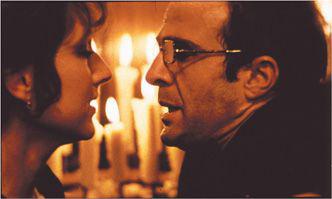
4.76 An orange filter suggests that all the light in this scene from
The Green Room
comes from candles.
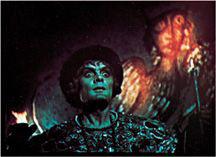
4.78 … but a blue light also suddenly and briefly shines on it until it disappears and the scene continues.
Most film lighting is arranged as part of preparation for live-action filmmaking. But what if the settings and figures are created with a computer? Scanning a model or motion-capturing a figure does not record the light falling on it, and it comes out a neutral gray all over. Animators add simulated light to a scene using special programs. Watch the credits for any special-effects-heavy film, and you will see long lists of names of people dealing with light and shade.
In
The Golden Compass,
the vicious combat between two armored polar bears was created entirely digitally. The fight takes place with a bright sun low in the sky, coming from off right, and the icy clearing contains shadows with bright stretches where the light shines between the surrounding crags
(
4.79
).
Simulated light is also used in cartoons, where all the mise-en-scene is created via computers. Pixar’s
Cars
experimented with the difficult challenge of rendering the look of colored lights reflected in metal and glass surfaces
(
4.80
).
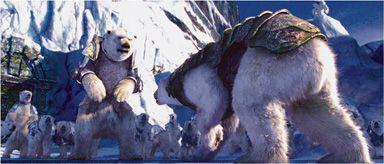
4.79 In
The Golden Compass,
stark arctic sunshine from offscreen right falls as sidelight on the snow and the fighting bears. Simulated fill light was added to the onlookers and in areas of attached shadows on the foreground bears.
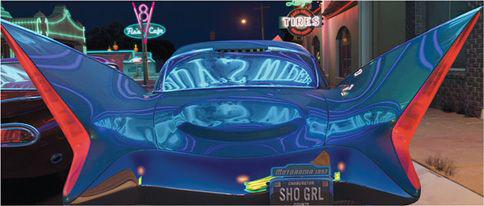
4.80 A virtuoso display of computer-simulated lighting, with colored neon signs reflecting in shiny, colored surfaces as the
Cars
cruise through their small-town street.
We are used to ignoring the illumination of our everyday surroundings, so film lighting is also easy to take for granted. Yet the look of a shot is centrally controlled by light quality, direction, source, and color. The filmmaker can manipulate and combine these factors to shape the viewer’s experience in a great many ways. No component of mise-en-scene is more important than what Sternberg called “the drama and adventure of light.”
The director may also control the behavior of various figures in the mise-en-scene. Here the word
figures
covers a wide range of possibilities, since the figure may represent a person but could also be an animal (Lassie, the donkey Balthasar, Donald Duck), a robot (R2D2 and C3PO in the
Star Wars
series), an object
(
4.81
),
or even a pure shape
(
4.82
).
Mise-en-scene allows such figures to express feelings and thoughts; it can also dynamize them to create various kinetic patterns.
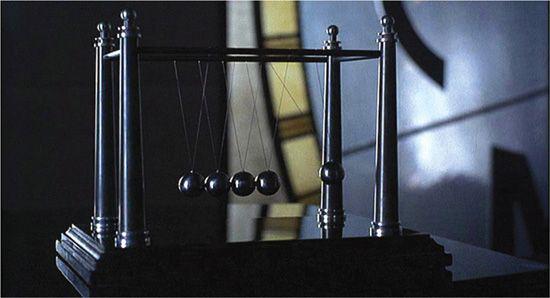
4.81 In
The Hudsucker Proxy,
when the mailboy Norville proposes his new toy idea, the clicking balls on his boss’s desktop suddenly and inexplicably stop.
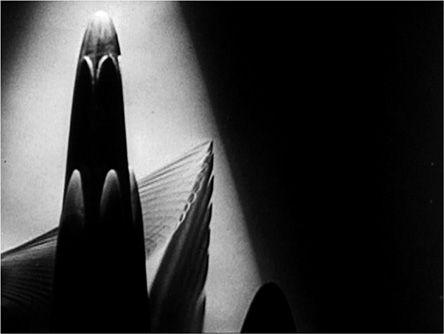
4.82 The abstract film
Parabola
uses lighting and a pure background to emphasize sculptural forms.
In
4.83
, from
Seven Samurai,
the samurai have won the battle with the bandits. Virtually the only movement in the frame is the driving rain, but the slouching postures of the men leaning on their spears express their tense weariness. In contrast, in
White Heat,
explosive movements and ferocious facial expressions present an image of psychotic rage
(
4.84
).
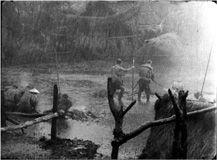
4.83 The actors strike weary poses in
Seven Samurai.
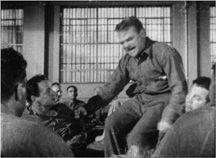
4.84 In
White Heat,
Cody Jarrett (James Cagney) bursts up from the prison mess table after learning of his mother’s death.
In cinema, facial expression and movement are not restricted to human figures. In one type of animated film, puppets are manipulated frame by frame through the technique of
stop-action
or
stop-motion
(
4.85
).
The filmmakers can also stage action without three-dimensional objects moving through real space. Images of characters that never existed, like Shrek or Daffy Duck, can be used in animated cartoons. In science-fiction and fantasy movies, robots and fabulous monsters created as models can be scanned and movement added via computer manipulation (
1.27
). Sophisticated digital techniques also allow filmmakers to motion-capture many points of movement on actors’ faces and transfer their performances to computer-generated creatures
(
4.86
).
